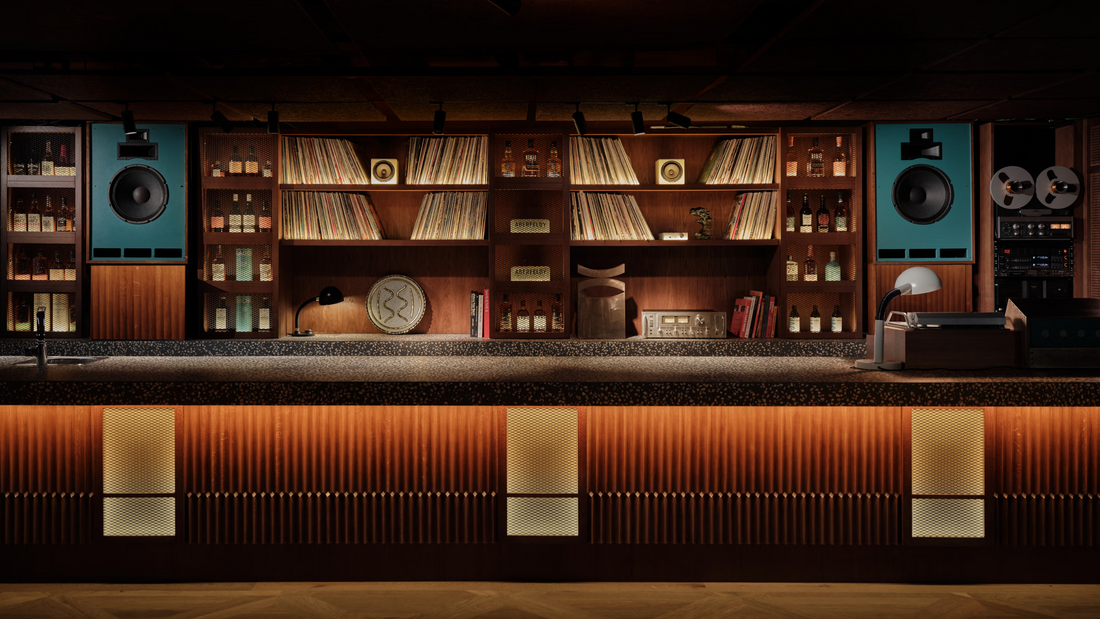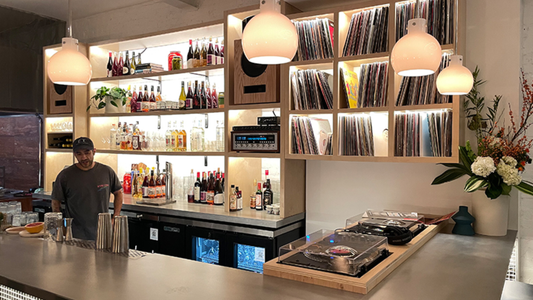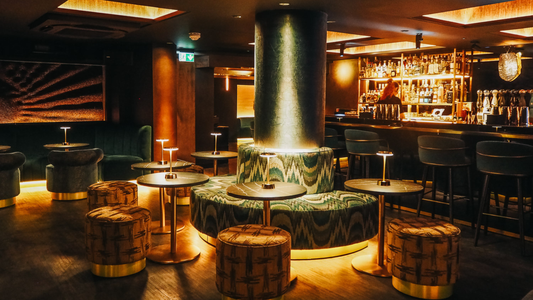
A Cloistered Ceremony of Sound and Spirit
By Rafi Mercer
New Listing
The Kissaten is one of Lisbon’s most poetic listening bars — explore more in our Portugal Music Venues guide.
Venue Name: The Kissaten
Address: Rua Camilo Castelo Branco 18 (Locke de Santa Joana), Lisbon, 1150-294
Website: The Kissaten
Instagram: @thekissaten
Phone: Available via website
Spotify Profile: Not applicable
The first impression is not made by sound at all, but by silence. Lisbon’s streets, ever alive with the chatter of cafés, the rattle of trams and the pulse of late-night laughter, begin to fade as you step through the threshold of The Kissaten. It feels less like entering a bar and more like descending into a cloister, where every element — from the weight of the door to the filtered light that falls across oak and velvet — is designed to adjust your posture, your breathing, your readiness to listen.
Inside, the room has a low amber glow. Light falls in thin ribbons across cork-lined walls, softening the acoustics and lending warmth to every corner. Banquettes upholstered in deep burgundy curve along the edges, creating alcoves of intimacy where couples and solitary listeners alike sink into the architecture of sound. This is not a place for spectacle. It is a place for presence.
The sound system is as much a piece of architecture as the room itself. Horn-loaded speakers stand like sculptures behind the bar, their wooden flares both functional and ceremonial. They don’t shout; they project with ease and grace, carrying detail across the room without ever tipping into harshness. The mixer, a bespoke rotary unit built with the kind of obsessive care one normally reserves for musical instruments, gleams under a low lamp. Next to it, vintage EMT turntables — once used in London’s hallowed underground clubs — turn with a kind of dignified patience. They are not here for novelty, nor nostalgia, but because they carry a sound that feels timeless.
Shelves of vinyl line the alcoves like a library of lives lived. The spines reveal worlds — a Portuguese fado pressing from the 1960s, a Japanese jazz reissue, a Detroit techno 12-inch, a Brazilian bossa nova LP faded by decades of handling. The music here is not performed but invited. Listeners are often drawn to the ritual of selecting a record, lifting the sleeve, feeling the weight of the vinyl itself. Each gesture is deliberate: sliding the record from its paper sleeve, laying it on the platter, lowering the arm. In an age of frictionless streaming, this slowness feels radical.
It is matched, bottle for bottle, by what sits behind the bar. The Kissaten is home to Portugal’s largest whisky collection, numbering more than a hundred labels. Japanese expressions hold a place of pride: Yamazaki, Hakushu, Hibiki, Nikka — each bottle a reminder that The Kissaten is deeply informed by Japan’s kissaten culture, where cafés were once places of intellectual exchange and quiet reverie. Alongside them stand Scotch giants from Islay and Speyside, rich with peat and history, as well as American bourbons with sweeter notes of caramel and oak. To sip here is to travel, glass in hand, while the turntable spins its own kind of journey.
The pairing of vinyl and whisky is not simply indulgent. It is elemental. One sharpens the other. The texture of a Coltrane solo seems more biting when chased by an Islay malt; the weight of a dub bassline seems rounder under the influence of a softer Japanese blend. The Kissaten is not a place where you drink while music happens to be playing. It is a place where listening and tasting fuse into one.
There is, crucially, no rulebook imposed on the guest. Some listening bars enforce a kind of sanctity of silence. At The Kissaten, reverence comes not from prohibition but from atmosphere. Conversation ebbs and flows, yet it never dominates. The sound system holds its own without aggression, the records chosen with a curator’s ear but not a dictator’s hand. The room itself seems to guide behaviour: people speak in softer tones, pause mid-sentence to hear a passage of piano, lean back with eyes closed as a record hits its stride.
The architecture of listening here is subtle but powerful. The cork-lined walls absorb excess resonance, allowing music to bloom without distortion. Wooden beams frame the ceiling, their rough texture catching and dispersing higher frequencies. Tables are spaced generously, creating pockets of private space while still allowing a collective hum. It is a design not just for ears but for bodies — a room that shapes the way you occupy it.
In the corner, a Revox tape deck waits patiently, its reels gleaming like the eyes of a quiet observer. A Sony CD carousel sits beside it, a reminder that fidelity has many forms, that purity of sound is not bound to one era. The signal path is tuned for clarity, not fetishised perfection: an Audeze DAC ensures digital input sings with warmth, while the rotary mixer gives even the humblest pressing a chance to glow. This is not a shrine to equipment but to the act of listening itself.
On some nights, tastings become performances. A visiting distiller will stand at the bar, pouring half measures while a record spins — Miles Davis with a Highland single malt, Aretha Franklin with a Kentucky bourbon. The ritual is theatrical but never ostentatious; it is a choreography of taste and sound that leaves an impression deeper than either element could achieve alone.
Other evenings are quieter still. A single record plays across its two sides, unbroken, while small groups linger in thought. A couple near the back leans into one another, eyes closed, hands wrapped around tumblers that catch the low light. A solitary guest scribbles in a notebook, occasionally pausing to tilt their head as if to follow a line of saxophone deeper into its phrasing. Here, listening is not an activity added to a night out — it is the night itself.
The Kissaten also plays with time. To step inside is to move at a different rhythm. Records spin at their own pace, whisky opens up over minutes, not seconds. The longer you stay, the more the outside world recedes. Lisbon is still there — the tram bells, the sea breeze, the chatter spilling out of pastelarias — but here those sounds are distant, softened, almost like a memory. The Kissaten replaces them with its own vocabulary: the crackle of vinyl, the soft clink of ice, the faint thud of a stylus dropping onto wax.
And when you leave, the city sounds sharper. The streetlamps seem brighter, the night air cooler, the rhythm of your steps more distinct. That is the geometry of listening The Kissaten teaches you: to notice sound, to savour it, to carry it back out into the world.
It is rare, in any city, to find a space where architecture, acoustics, and culture align so precisely. The Kissaten achieves this not by spectacle, but by restraint. It is a room that asks only for your presence, and in return it reshapes the way you hear.
Rafi Mercer writes about the spaces where music matters. For more stories from Tracks & Tales, subscribe here, or click here to read more.







